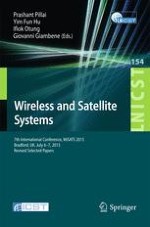This book constitutes the proceedings of the 7th International Conference on Wireless and Satellite Services, WiSATS 2015, held in Bradford, UK, in July 2015. The conference was formerly known as the International Conference on Personal Satellite Services (PSATS) mainly covering topics in the satellite domain. As the scope of the conference widened to include wireless systems, the conference was renamed WiSATS.
The 29 revised papers were presented at the conference in three technical sessions and one special session on “Network Coding for Satellites”. WiSATS 2015 also hosted two workshops along with the main conference: The first workshop, Communication Applications in Smart Grid (CASG 2015), focused on the merging area of using communication technology within the electricity power grid for smart monitoring and control. The second workshop, Advanced Next-Generation Broadband Satellite Systems (BSS 2015), focused on the use of satellite systems for providing next-generation broadband services.
